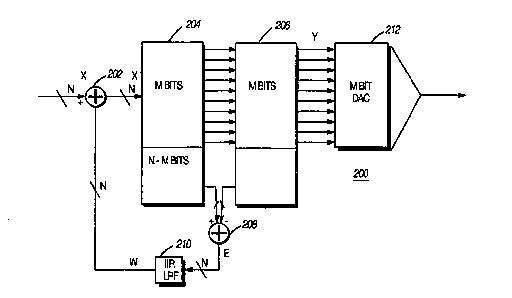Some of the information on this Web page has been provided by external sources. The Government of Canada is not responsible for the accuracy, reliability or currency of the information supplied by external sources. Users wishing to rely upon this information should consult directly with the source of the information. Content provided by external sources is not subject to official languages, privacy and accessibility requirements.
Any discrepancies in the text and image of the Claims and Abstract are due to differing posting times. Text of the Claims and Abstract are posted:
| (12) Patent Application: | (11) CA 2185026 |
|---|---|
| (54) English Title: | METHOD AND APPARATUS FOR REDUCING QUANTIZATION NOISE |
| (54) French Title: | PROCEDE ET APPAREIL DESTINE A REDUIRE LE BRUIT DE QUANTIFICATION |
| Status: | Deemed Abandoned and Beyond the Period of Reinstatement - Pending Response to Notice of Disregarded Communication |
| (51) International Patent Classification (IPC): |
|
|---|---|
| (72) Inventors : |
|
| (73) Owners : |
|
| (71) Applicants : |
|
| (74) Agent: | GOWLING WLG (CANADA) LLP |
| (74) Associate agent: | |
| (45) Issued: | |
| (86) PCT Filing Date: | 1995-12-28 |
| (87) Open to Public Inspection: | 1996-08-22 |
| Examination requested: | 1996-09-06 |
| Availability of licence: | N/A |
| Dedicated to the Public: | N/A |
| (25) Language of filing: | English |
| Patent Cooperation Treaty (PCT): | Yes |
|---|---|
| (86) PCT Filing Number: | PCT/US1995/017018 |
| (87) International Publication Number: | US1995017018 |
| (85) National Entry: | 1996-09-06 |
| (30) Application Priority Data: | ||||||
|---|---|---|---|---|---|---|
|
In a quantization noise reduction circuit (200), a feedback signal (W) is added to an input signal (X) to the quantization circuit
to reduce quantization noise. The feedback signal is generated as a filtered difference between a sample of an N bit signal (X') and a
time coincident sample of an M bit quantized signal, where M < N. The feedback signal is subtracted from the input signal (X) prior to
quantization thereby introducing out of band noise into the input signal for reducing in band noise in the quantized signal (Y).
Dans un circuit de réduction du bruit de quantification (200), un signal de rétroaction (W) est ajouté à un signal d'entrée (X) dans le circuit de quantification afin de réduire le bruit de quantification. Le signal de rétroaction est généré en tant que différence de filtrage entre l'échantillon d'un signal (X') à N bits et un échantillon à coïncidence temporelle d'un signal quantifié à M bits où M < N. Le signal de rétroaction est déduit du signal d'entrée (X) avant la quantification, ce qui permet d'introduire du bruit hors bande dans le signal d'entrée afin de réduire le bruit de bande dans le signal quantifié (Y).
Note: Claims are shown in the official language in which they were submitted.
Note: Descriptions are shown in the official language in which they were submitted.

2024-08-01:As part of the Next Generation Patents (NGP) transition, the Canadian Patents Database (CPD) now contains a more detailed Event History, which replicates the Event Log of our new back-office solution.
Please note that "Inactive:" events refers to events no longer in use in our new back-office solution.
For a clearer understanding of the status of the application/patent presented on this page, the site Disclaimer , as well as the definitions for Patent , Event History , Maintenance Fee and Payment History should be consulted.
| Description | Date |
|---|---|
| Inactive: IPC from PCS | 2022-09-10 |
| Inactive: IPC from PCS | 2022-09-10 |
| Inactive: IPC from PCS | 2022-09-10 |
| Inactive: First IPC from PCS | 2022-09-10 |
| Inactive: IPC from PCS | 2022-09-10 |
| Inactive: IPC expired | 2009-01-01 |
| Inactive: IPC from MCD | 2006-03-12 |
| Inactive: IPC from MCD | 2006-03-12 |
| Inactive: IPC from MCD | 2006-03-12 |
| Inactive: IPC from MCD | 2006-03-12 |
| Application Not Reinstated by Deadline | 1999-12-29 |
| Time Limit for Reversal Expired | 1999-12-29 |
| Inactive: Abandoned - No reply to s.30(2) Rules requisition | 1999-02-24 |
| Deemed Abandoned - Failure to Respond to Maintenance Fee Notice | 1998-12-29 |
| Inactive: S.30(2) Rules - Examiner requisition | 1998-11-24 |
| Inactive: Status info is complete as of Log entry date | 1998-07-23 |
| Inactive: Application prosecuted on TS as of Log entry date | 1998-07-23 |
| All Requirements for Examination Determined Compliant | 1996-09-06 |
| Request for Examination Requirements Determined Compliant | 1996-09-06 |
| Application Published (Open to Public Inspection) | 1996-08-22 |
| Abandonment Date | Reason | Reinstatement Date |
|---|---|---|
| 1998-12-29 |
The last payment was received on 1997-09-19
Note : If the full payment has not been received on or before the date indicated, a further fee may be required which may be one of the following
Patent fees are adjusted on the 1st of January every year. The amounts above are the current amounts if received by December 31 of the current year.
Please refer to the CIPO
Patent Fees
web page to see all current fee amounts.
| Fee Type | Anniversary Year | Due Date | Paid Date |
|---|---|---|---|
| Request for examination - standard | 1996-09-06 | ||
| MF (application, 2nd anniv.) - standard | 02 | 1997-12-29 | 1997-09-19 |
Note: Records showing the ownership history in alphabetical order.
| Current Owners on Record |
|---|
| MOTOROLA, INC. |
| Past Owners on Record |
|---|
| JAMES FRANK LONG |
| YUDA YEHUDA LUZ |